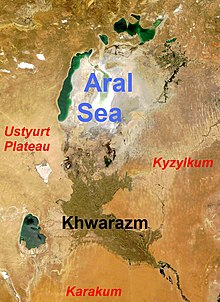 | |
| Geographical range | Aral Sea region |
|---|---|
| Period | Bronze Age |
| Dates | c. 2000 BC – 1000 BC |
| Preceded by | Kelteminar culture |
The Suyarganovo culture was an archaeological culture of the late Bronze Age, appearing at the beginning of the second millennium BC,[1] extending to around 1000 BC. The population of Suyarganovo culture, also known as Suyargan culture, lived in Aral, near Akcha Darya river (Amu Darya delta), the area of the historic Khwarezm. Stanislav Grigoriev (2016) suggests Suyarganovo culture began sometime around 2500-2000 BC.[2]
In the middle of the second millennium BC, the population of Suyarganovo culture coexisted with the tribes of the Tazabagyab culture. Typical ceramics - flat-bottomed vessels (often with a red or orange color) with a short neck (often with carvings) and rounded torso. Homes and dwellings of Suyarganovo occupies a large area, mostly along the banks of fluvial channels.
- ^ Kuzmina, Elena Efimovna, (2008). The Prehistory of the Silk Road, Victor H. Mair (ed.), University of Pennsylvania Press, Philadelphia, p. 78: "...This culture appeared in the first half of the second millennium B.C., developing out of the local Kelteminar Culture (Gulyamov et al. 1966)..."
- ^ Grigoriev, Stanislav, (2016). Metallurgical Production in Northern Eurasia in the Bronze Age, Archaeopress Publishing Ltd., p. 664: "...With intensification of aridization in the second half of the 3rd [millennium] BC considerable qualitative changes begun here. The Kelteminar culture is succeeded by a series of cultures of the Early Bronze Age. It is the Suyargan culture on the lower Amu-Darya River...formed on the basis of the late Kelteminar under an influence of the southern impulses from North-Eastern Iran..."